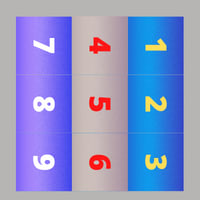Problem Statement :-
You are given an n x n 2D matrix representing an image, rotate the image by 90 degrees (clockwise).
Example 1:
Input: matrix = [[1,2,3],[4,5,6],[7,8,9]]
Output: [[7,4,1],[8,5,2],[9,6,3]]
after rotating by 90 degree,
Solution 1
from the above images, you can see, after the rotation, the first row of the matrix has turned into the last column of the matrix and the second row of the matrix has turned into the second last column, and so on.
so what we are going to do is, initialize one more matrix rotated and copy the first row from the original matrix to the last column of the new matrix rotated, and so on.
step-1 initialize a n*n size of matrix rotate.
step-2 run a loop from i=0 to n
1. run another loop from
j=0ton.2. copy
matrixvalues to the last column ofrotatematrix.
rotated[j][n-i-1] = matrix[i][j]
step-3 end.
Java
class Solution {
public void rotate(int[][] matrix) {
int n = matrix.length;
int rotated[][] = new int[n][n];
for (int i = 0; i < n; i++) {
for (int j = 0; j < n; j++) {
rotated[j][n - i - 1] = matrix[i][j];
}
}
for(int i=0; i<n;i++)
System.out.println(Arrays.toString(rotated[i]));
}
}
Time Complexity : O(n*n),bcoz we are running two loops.
space Complexity : O(n*n),initialising a new n*n matrix.
Solution 2
if you observed the first row of the output, is nothing, just the reverse of the first column.
for the expected output, first, we have to transpose the matrix and then reverse each row of the matrix.
lets understand it in a visual way.

step-1 transpose the matrix. (changing rows to columns & columns to rows)
step-2 reverse each row of the matrix.
Java
class Solution {
public void rotate(int[][] matrix) {
int n = matrix.length;
// transpose the matrix
for(int i=0; i< n;i++){
for(int j=0; j<i; j++){
swap(matrix,i,j);
}
}
// reverse rows
for(int i=0; i<n;i++){
reverse(matrix[i],n);
}
}
private void swap(int[][] matrix,int i, int j){
int temp = matrix[i][j];
matrix[i][j] = matrix[j][i];
matrix[j][i] = temp;
}
private void reverse(int[] row,int n){
for(int i=0; i<n/2;i++){
int temp = row[i];
row[i] = row[n-i-1];
row[n-i-1] = temp;
}
}
}
Time Complexity : transposing the matrix + reversing each row of the matrix,then O(n*n) + O(n*n).
space Complexity : in this case we are not using any extra space,then O(1).
Thank you for reading this article I hope I explained it clearly.






Top comments (2)
Thanks! Aren't there any more efficient algo for matrix operation? What about Strasen's one. You can check if he proposed some better to quadratic. Not sure about that. How about this(taken from quad trees):
Quad trees are interesting thing to read.
thanks for sharing about interesting algos. I will read.